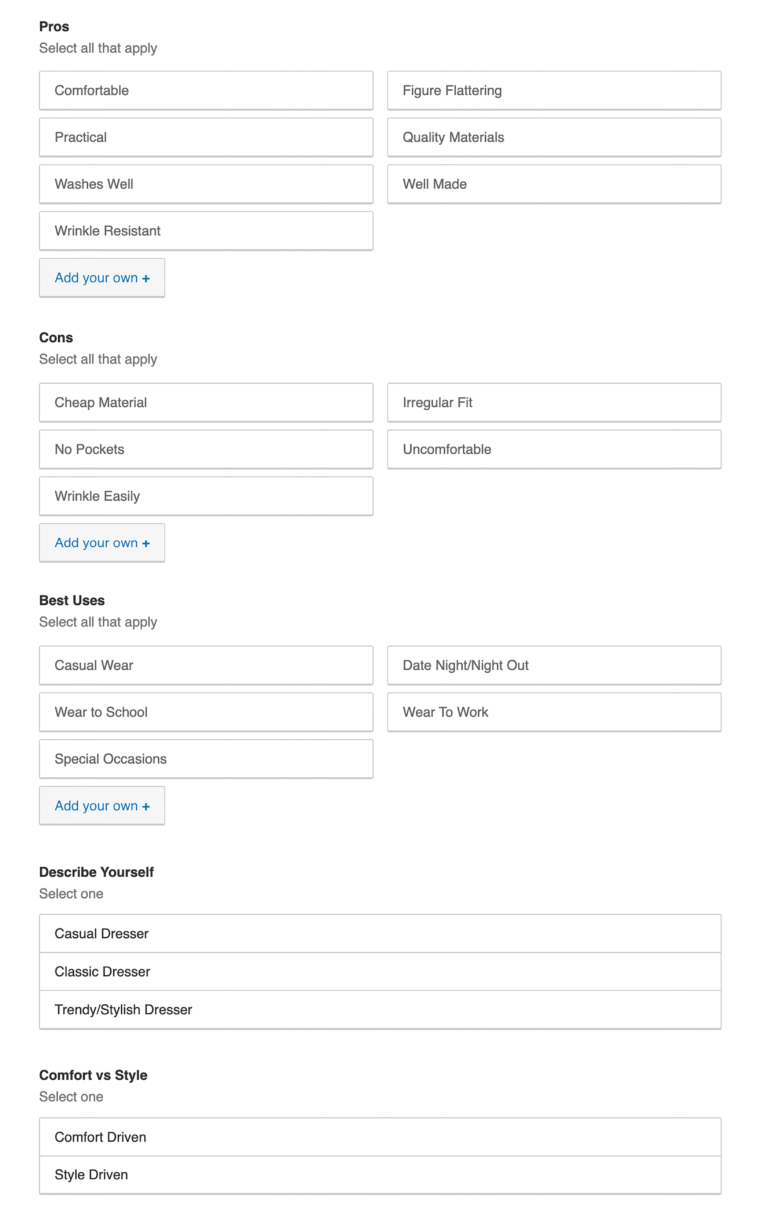Optimizing your review collection form is key to generating rich, detailed reviews that boost conversion and fuel informed purchase decisions. You should generally choose no more than 5 customized segments, but if you were to include everything here’s what it could look like:

The Basics
Rating, headline, comments, nickname, location. These are the basics. Think of these questions as the foundation from which all review collection forms are built.
Review Meter
Longer, more detailed reviews are more helpful to shoppers. Including a review meter, an interactive character count that appears below the comments box, in your form can help you generate more of those long, detailed reviews.
Helper Text
Faced with that big blank comments box, some reviewers just don’t know what to write. One way to get the creative juices flowing (and get shoppers to write longer, more detailed reviews) is to include some helper text in the comments field. This text serves as writing prompts for the reviewer.
Add an Image
Site visitors who interact with user-generated imagery on a product page convert at a rate that’s more than 106% higher than average! But in order to display this content, you must first collect it. The best way to do this is through the review collection form.
Bottom Line
Be sure to include a section that asks whether the reviewer would or would not recommend the product in question to a friend. At the end of the day, what the reader really wants to know is whether or not the reviewer recommends the product in question.

Size/Fit
If you’re a brand or retailer that sells apparel and footwear, collecting size and fit information within the review collection form is a must.

Pros & Cons, Best Uses
Research tells us that visitors who filter by these “tags” convert at a rate that’s more than 78% higher than average. Including pros and cons in this way can help get a customer’s thoughts/juices flowing. As a best practice, these are typically served up before the review comment.
Describe Yourself
Consumers value reviews because it’s content written by others like them, without any motive. This is especially true for certain product categories.

Age Range, Skin Type
A skincare company might opt to include questions about the reviewer’s skin type and skin concerns. That way, they can add a feature to their display allowing shoppers to easily find content written by others with similar skin types and concerns.
How do you figure out which merchant-specific questions to ask in your review collection form? Consider what information would be most helpful to shoppers trying to decide if your product is the right fit for them.
How do you figure out which merchant-specific questions to ask in your review collection form? Consider what information would be most helpful to shoppers trying to decide if your product is the right fit for them.

Email opt-in
There are some instances where it makes sense to collect data in your review collection form that won’t be included in your review display–but will be leveraged internally. For example, you may want to include a newsletter opt-in form to your review collection. It’s a great way to grow your email list, with little effort.
Key Takeaways:
- Optimizing your write-a-review form is key to increasing both review quality and quantity.
- Beyond the fundamentals, there’s no one-size-fits-all review collection form.
- Consider what data is important for both your brand and your shoppers, but make sure not to go overboard. Optimize based on what the conversion data tells you.
Additional Resources:
- Inspiration Station: Review collection forms from leading brands.
- Review Collection Metrics to Monitor: How to use data to optimize your review collection strategy.
- Review Display Metrics to Monitor: How to optimize your review displays and the review data you capture based on purchase behavior.


